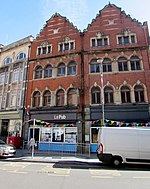Usk Railway Bridge

The Usk Railway Bridge is a railway viaduct in Newport city centre, Wales. It crosses the River Usk in an east—west direction, carrying the Great Western Main Line. The original bridge was constructed for the South Wales Railway and designed by the accomplished railway engineer, Isambard Kingdom Brunel. Brunel's viaduct, which was primarily constructed of creosote-treated timber, suffered a catastrophic fire near completion, resulting substantial delay and its rebuilding. The redesigned structure used considerably more wrought iron in place of wood, and included the first use of the now-common bow-string-shaped girder. This first bridge was opened to traffic during 1850. During the late 1880s, a second bridge was constructed alongside the first, which benefitted from a simpler design in comparison to the first. During the 1910s, the second bridge was extended to accommodate a quadruple track configuration, enabling the original bridge to be retired during 1925. During 2019, the lines across the second bridge were electrified as part of the 21st Century upgrade of the Great Western Main Line.
Excerpt from the Wikipedia article Usk Railway Bridge (License: CC BY-SA 3.0, Authors, Images).Usk Railway Bridge
Heidenheim Drive, Newport Crindau
Geographical coordinates (GPS) Address External links Nearby Places Show on map
Geographical coordinates (GPS)
| Latitude | Longitude |
|---|---|
| N 51.59113 ° | E -2.99453 ° |
Address
Heidenheim Drive
NP20 9AR Newport, Crindau
Wales, United Kingdom
Open on Google Maps










